Choosing the right beginner bike is very important, but luckily there are a lot of different bikes that I’d say qualify as a good beginner bike.
The best beginner motorcycle should not be too powerful, too heavy, too tall, or too expensive. A bike with neutral ergonomics will help new riders learn clutch, throttle, and brake control. A small second-hand motorcycle is ideal for beginner riders who will likely drop the bike at some point.
I know you are anxious to start riding and you’ve most probably got your mind set on a specific first motorcycle. Please read the rest of the post and if you are still convinced that you should get your dream bike right away, I won’t stand in your way 😉
Beginner Bikes: Engine size and power
If you are a total beginner, I would recommend a motorcycle with a small displacement engine (like a 250 or 300 cc four-stroke). I know you might be tempted to go straight for that big, powerful bike with the large engine. Here are a few reasons why a powerful bike is not a good idea for a beginner rider:
Too Much Power
Beginner riders first need to get used to clutch and throttle control as they learn to pull away. It can take some time before a new rider gains confidence. On a too powerful bike, it can be very intimidating. You’ll be easily overwhelmed by the sheer force of the engine which could result in a loss of control and a serious accident.
Aggressive Throttle Response
Powerful bikes generally have a more aggressive throttle response. That means, a small input in the throttle can have a big effect on how fast the bike starts to move. If you are not used to this sudden movement, you could grab a bigger fist full of throttle and send the bike out from under you. This is referred to as whiskey-throttle. Don’t believe me, go search for it one Youtube!
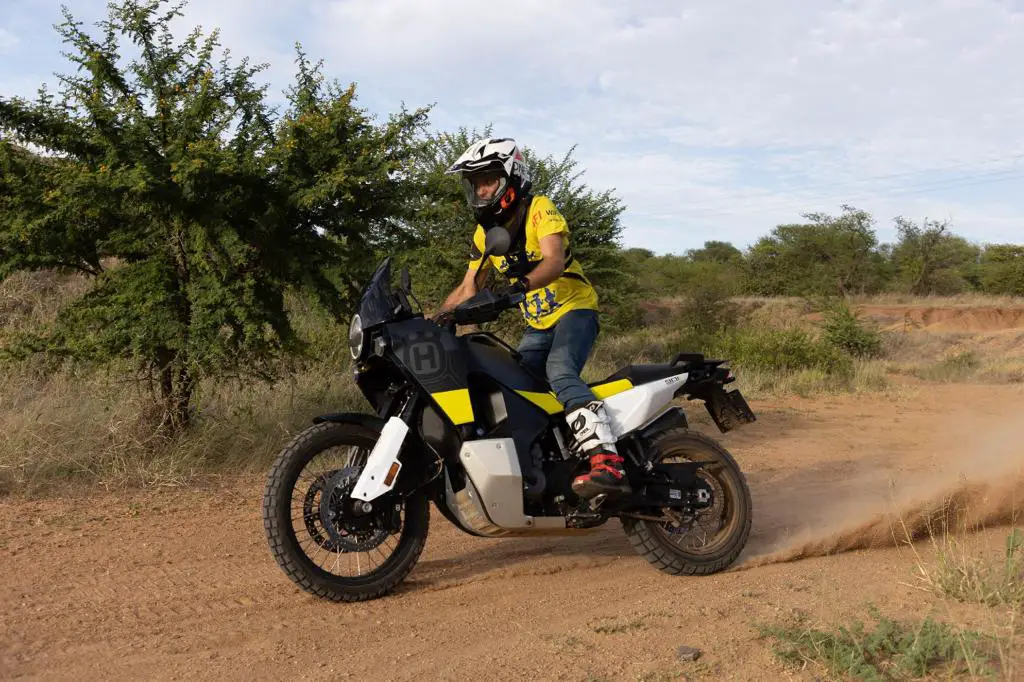
Too Much Speed
Large capacity bikes, like litre sports bikes or the top-of-the-range adventure bikes, can easily and quickly go much faster than the legal highway speed limit. I am not worried about you getting into trouble with the law. If you ride at those speeds, things happen very quickly. And if you are new to riding, you won’t have the instincts and muscle memory to respond quick enough.
I’ve had warthogs run out in front of me at modest speeds, which required quick reactions that comes from years of riding experience.
Yes, I know. You are responsible. You know your own limits. You will take it easy in the beginning. Rubbish! I was also young and reckless. And even now that I am older, wiser, and more responsible (being a family man), I still get the urge to just see what the bike can do.
No matter how safely you think you’re doing it, going fast on a motorcycle remains super dangerous and if you are inexperienced, it just take one mistake to send you up to the pie in the sky.
Slow Bikes Make Faster Riders
Say what now?! How can a slow bike make you faster than a fast bike. Well, it is all in the skills and habits that you learn when you start out. If you learn to ride on a slow motorcycle, you’ll firstly master clutch and throttle control sooner because you are more relaxed.
Then once you get more comfortable, you will start riding harder. At some point, if your bike is slow enough, you will start riding the bike at or close to its limits. This will actually be more fun than holding back on a bike that’s way too fast.
For example, I once tested a Honda CBR 125 and a Honda CBR 1000 RR Fireblade in the same week. I had a blast trying to get the maximum out of the little 125 over mountain passes and on the straights. I actually managed 147 km/h once.
On the Fireblade, however, I could barely get to third gear before having to let off the throttle. In fact, I tried to get to the redline and reached it in first gear doing 155 km/h. Believe me when I say, the slow bike is more fun and makes you a better rider sooner.
Beginner Bikes: Weight
While the weight of a motorcycle is irrelevant in many situations, when learning to ride you will be glad you chose a light-weight bike. When starting out, the impact of motorcycle weight on a beginner rider can make all the difference.
Balance
All motorcycles are perfectly balanced around the mid-point, when it is standing straight up. You can hold a 500 lbs bike upright while standing next to it without exerting any effort. It is when the bike leans over that you’ll notice its mass.
Some motorcycles, like sports bikes, tip over easily. They were designed like that to make them turn in quicker at high speeds around a race track. A light-weight small dual sport, for instance, will be easy to keep upright even if you tip it over slightly (for instance when turning it around in the garage).
Confidence
Regardless of whether you are able to move around and hold up a bike, it is more about the confidence that a light bike inspires. When my wife learned to ride, she got an old 1979 Yamaha MR 50. The thing barely weighed 70 kg. As soon as she got comfortable, she bought a 420 lbs 1999 BMW F 650 ST.
She travelled everywhere on that BMW, but the weight of the bike was always in the back of her mind. Especially on uneven roads, going at walking pace. As a result, when we did our three month journey from Cape Town to Cairo, she opted for a small 200 cc delivery bike instead. It gave her a lot more confidence, even though she had already done thousands of miles on the BMW by then.
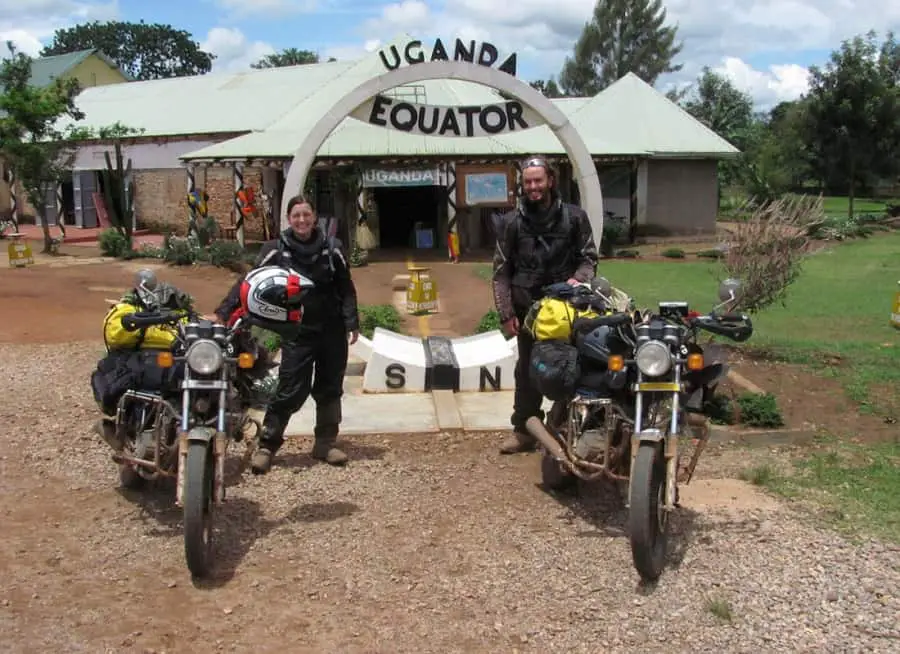
Slow speed manoeuvring
Motorcycles are design to stay upright when moving fast. That’s why Moto GP racers have to throw their bodies around to get the bikes to turn into a corner. It is when you ride slowly (think walking pace) that things get unstable and the weight starts to matter.
As a beginner rider, while you are still getting used to how the clutch, throttle and brakes work, you will spend a lot of time at low speeds. Possibly in an empty parking lot somewhere or in your back yard on the lawn. At these speeds, a heavy bike is a liability. The lighter your bike, the easier you’ll learn as you don’t have to worry about dropping your bike.
Pick it up
Yes, you will drop your bike. Maybe not right away. But sooner or later, every rider loses concentration (or grip in a wet puddle). Picking up a heavy bike on your own is not fun. It is also not good for your back. Get a light-weight bike to start out on. One that you can pick up with one hand.
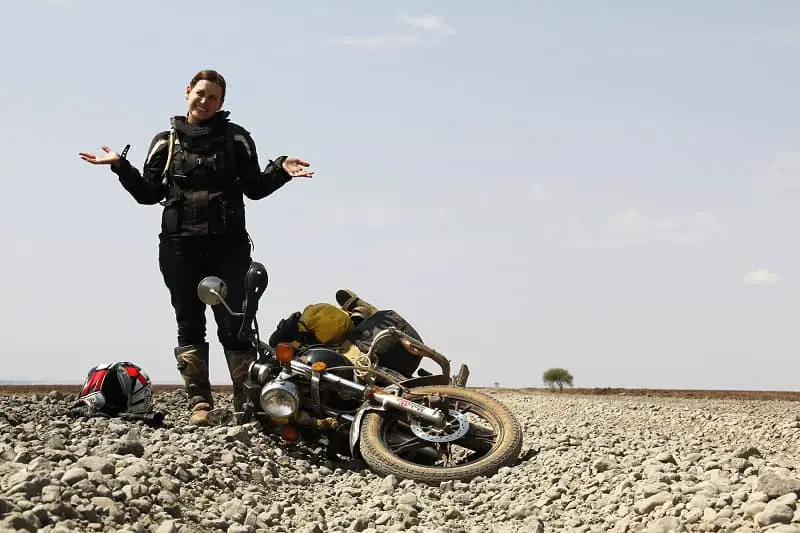
Check out my comprehensive post on motorcycle weights by type to find one that is light enough for you.
Beginner Bikes: Seat height
It is all about confidence when you learn to ride for the first time. Even more intimidating than weight is a bike that is too tall. As a beginner rider, you will feel way more comfortable if you can put both feet flat on the floor on either side of the motorcycle.
On many motorcycles, this is not possible for all but the tallest riders. Even at 6’1″ there are many motorcycles that won’t allow me to flatfoot it on both sides. Once you are more experienced, this is not an issue at all anymore.
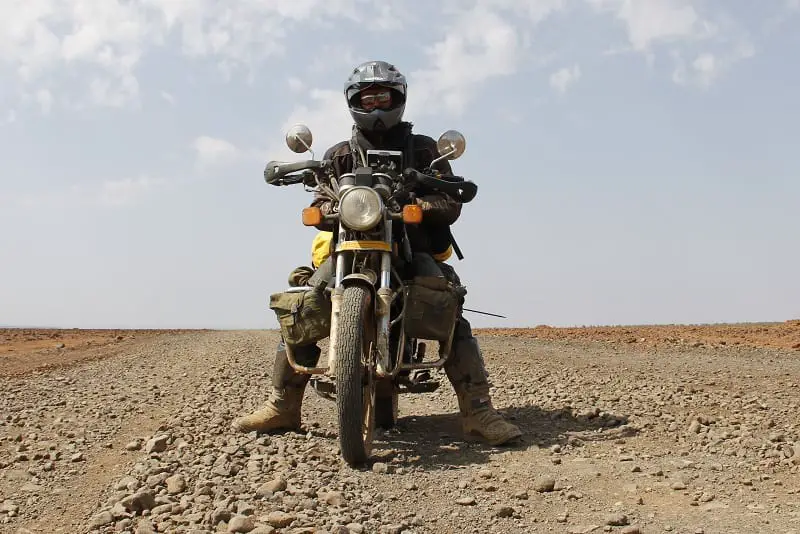
In those early stages you have to focus on so many things all at once. Clutch and throttle control. Braking with your right hand and right foot at the same time. Coming to a stop and pulling in the clutch. All of this is much easier if you have full control of the bike at standstill.
There’s nothing worse than putting a foot down and feeling the bike starting to tip over with a crowd of people watching you. It’s happened to me before. Get a bike with a low seat height to learn on and upgrade once you are comfortable with everything else.
Check out my comprehensive post on motorcycle seat heights by type.
Beginner Bikes: Ergonomics
A comfortable riding position is important for beginner riders. That’s why I recommend learning to ride on a small-capacity dual sport bike like a Yamaha XT 250 or even a Yamaha TW 200. Being able to reach the handlebars easily and sitting in a neutral position will just make everything else you need to focus on so much easier.
Smaller commuter bikes, dual sports or even cruisers like the Yamaha V-Star 250 are all perfect due to their neutral seating position. You don’t want to start learning on a sports bike like the Yamaha R6 or a fat cruisers like a Harley Softail right away.
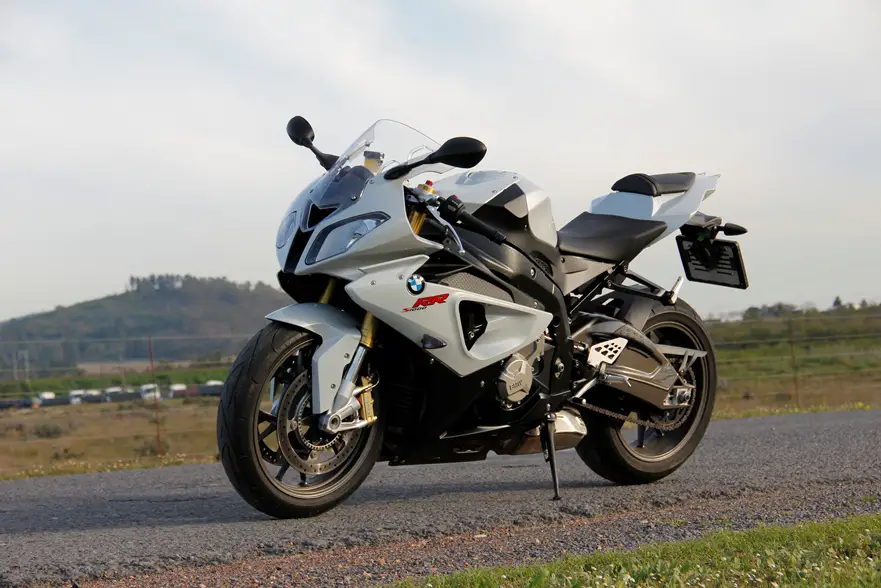
On a sports bike, you lean over way forward and the foot pegs are so high and close to your seat, that you are hunched over the handlebars in an uncomfortable position. This is definitely not the best way to inspire confidence when you are learning to use a clutch for the first time. You will also get tired quickly and start making costly mistakes.
On a big cruiser, you lean so far backward with your feet our in front of you. This is okay for cruising in a straight line, but terrible if you are trying to manoeuvre at low speed in an empty parking low, trying to avoid traffic cones to hone your skills.
Beginner Bikes: Controls and Drivetrain
The controls of the bike is not as important as the power delivery, weight and seat height. It is worth a quick mention, however, so here goes:
Clutch
As long as your clutch is operating correctly, you should be fine. Some modern motorcycles have a hydraulic clutch which offers a much lighter feel. This will help while learning to control the clutch while pulling away slowly. That doesn’t mean that a cable-operated clutch in no good.
The benefit of a cable-operated clutch is that it is easier to maintain. Yes, you have to adjust it every now and then due to the cable stretching, but there is no fluid that can leak out or that has to be bled. The type of clutch should not influence your decision on which beginner bike to get.
Transmission
The transmission on most bikes will be just fine for learning how to ride. I’d stay away from sports bikes with tall gearing. I once tested a Fireblade and did 95 mph in first gear. That’s hardly a great setup to learn to ride and shift gears.
The only other thing that I’ll mention here is that Harleys tend to have clunky gearboxes. While this is normal and part of their design, it can feel quite awkward, especially for a new rider.
Suspension
Bikes with very tall suspension, like dirt bikes, are designed to land massive jumps and can make it difficult for shorter riders to reach the ground. The Yamaha YZ 125 for instance, has a small engine but has one of the tallest seat heights due to its long-travel suspension.
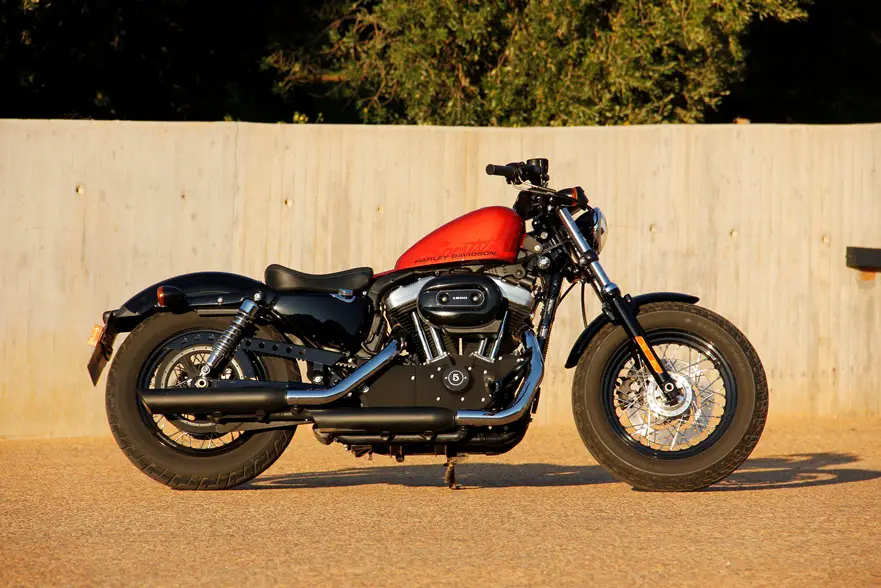
Sports bikes and cruisers, on the other hand, have very short suspension resulting in a harsh ride. While not a problem in itself, it can be quite uncomfortable and tiring. A small road bike like the CBR 300 R, or for taller riders, a CRF 300 L is a perfect compromise.
Brakes
If the bike has a disc brake up front, then you’re good. Some very older bikes, like my Yamaha AG 200, still have a drum brake in the front. This is okay while riding slowly, but at speed disc brakes offer better stopping power.
You don’t need anti-lock braking (ABS) brakes, but they can save you in case you slam on the brakes too suddenly, especially on slippery surfaces. Again, I would not let this affect my decision on which bike to buy as your first motorcycle.
One advantage of a motorcycle without ABS is that you do not run the risk of learning habits that rely on the system to save you. For example, if you are riding on wet tarmac, it is much better to learn to adjust your riding style as if you do not have any electronic safety nets.
Beginner Bikes: Cost
Maybe you are in the fortunate position where money is not a concern. But if you are like the rest of us, I suggest learning to ride on a less expensive bike to begin with. There is a very good chance that you will drop your bike at some point during the early stages of learning how to control the clutch, throttle and brakes.
I always suggest to beginner riders to learn on a second-hand bike. Preferably one that’s already a bit scratched up. That way, you won’t overpay when you buy it and you won’t lose as much when you sell it once you’re ready to upgrade to your dream bike.
It is also not just the initial purchase price that will cost you. As a beginner rider, you will have to spend some money on riding gear. The absolute minimum is a helmet and gloves, but I would highly recommend riding boots, trousers and a jacket. Things can go wrong very quickly and you’ll be grateful if you still have your skin on your palms and knees.
Then there’s insurance to think about. If you are only learning to ride for the first time, insurers will likely add a premium to your premium. A cheaper bike will cost less to insure. Once you have more experience, you can upgrade to a more expensive bike and offset the higher premiums with discounts for riding experience.
Beginner Bikes: Style
This is probably the most important aspect of choosing your first bike to learn to ride on. If your bike doesn’t make you smile, you won’t be in the right mindset to learn the fundamental skills to ride properly.
While there is some element of truth to this, it really is not true! 😉
Get whatever bike you can get your hands on for cheap, and learn to ride properly from the start. Don’t get a bike that’s too fast, just because you want a sports bike. And don’t get a bike that’s too tall or heavy because you’ve watched one too many Pol Tarres videos o YouTube.
There is enough time to get the bike you really want later on. The wait might even make the eventual purchase that much more special.
Beginner Bikes: Aftermarket and community support
While not directly impacting your ability to learn to ride as a beginner rider, there are some indirect benefits of choosing a motorcycle with a large following.
A motorcycle with a strong aftermarket and community following will make it easier to find replacement parts and accessories. There’s nothing more demotivating than a bike that won’t start. If your bike is a rare machine that was only manufactured for two years, you might end up waiting for months to get the parts you need.
I recently bought a 1995 KTM 250 EXC. It was a popular bike back then, but the fork seals are 49.5 mm and I spent months hunting them down on e-Bay. None of the suppliers shipped internationally, so I ended up having to ask friends of family to bring it home after a visit overseas.
If, on the other hand, you get a bike like the TW 200 which has been in production since 1987 and largely remained unchanged, parts are plentiful and easy to come by. You’ll get your bike running in no-time so you can spend valuable time in the saddle, becoming a better rider.
Another benefit of a popular model is the wealth of info available online, in forums, on Google, or on YouTube. You’ll also meet like-minded riding buddies more easily because there are just more people that own the same bike and spend time in the same Facebook groups.
This certainly was my experience while I owned and filmed YouTube videos on my Honda XR650L (which incidentally has been around since 1992).
Are These Motorcycles Good Beginner Bikes?
I’ve written a series of articles on different popular motorcycles and discuss whether each one is good for beginner riders that are just starting to learn to ride.
Check out the posts below to find out whether each of these bikes make good beginner motorcycles:
Harley-Davidson
Honda
Suzuki
Yamaha
Other Bikes
Beginner Bikes: Conclusion
The best bike to learn on is the one that you have. If you are a complete beginner that’s never been on a motorcycle before and you are looking for a first bike, then get one that’s not too powerful, heavy, tall, or expensive.
I’ve said it before and I’ll say it again: Learning to ride on a slow bike will make you a much better rider on a fast bike. It is also way more fun to ride the crap our of a slow bike, than it is to hold back nervously on a bike that is too fast. It just is.
Now get out there and learn to ride. Safely. Enjoy!
Francois

